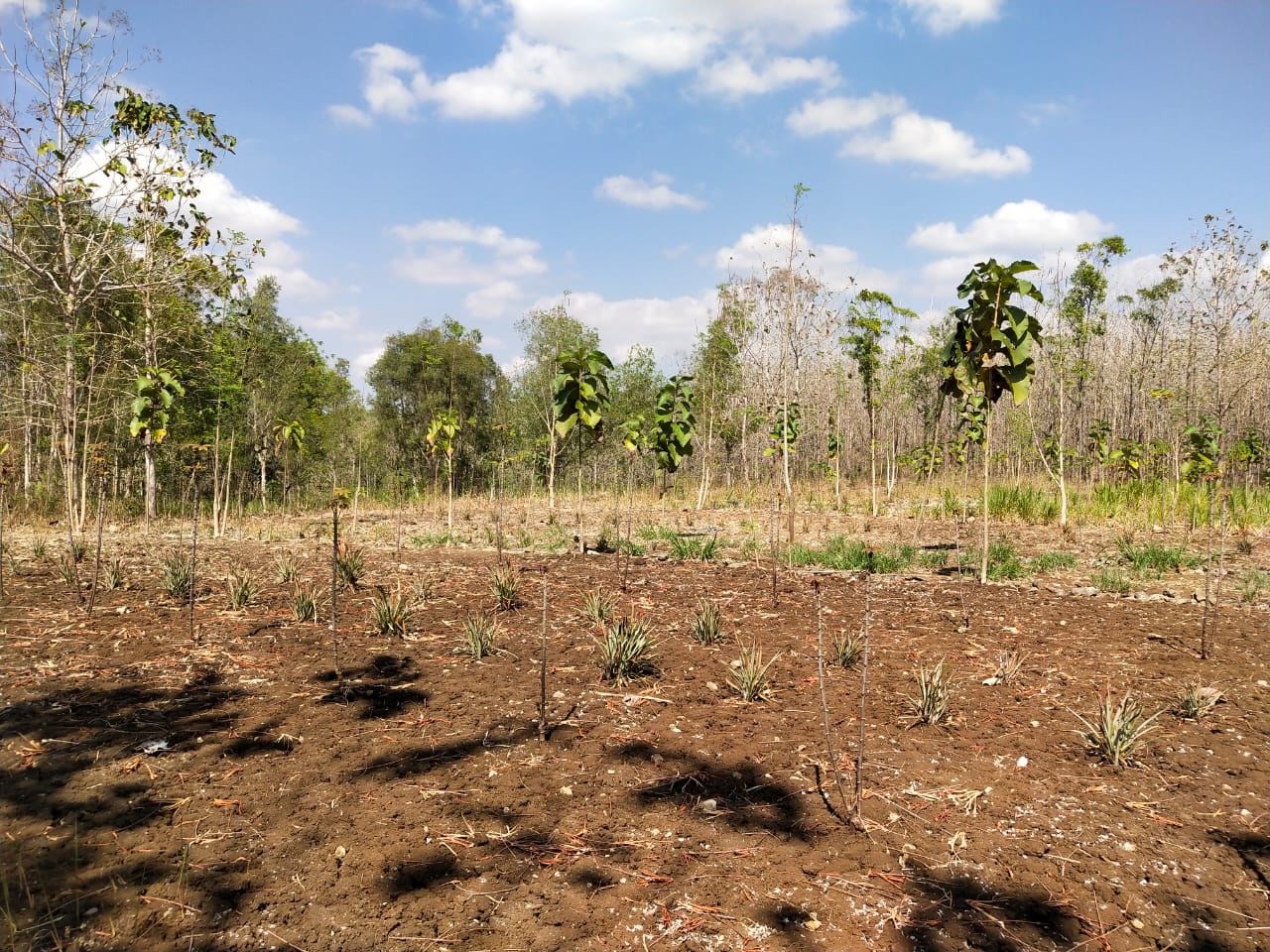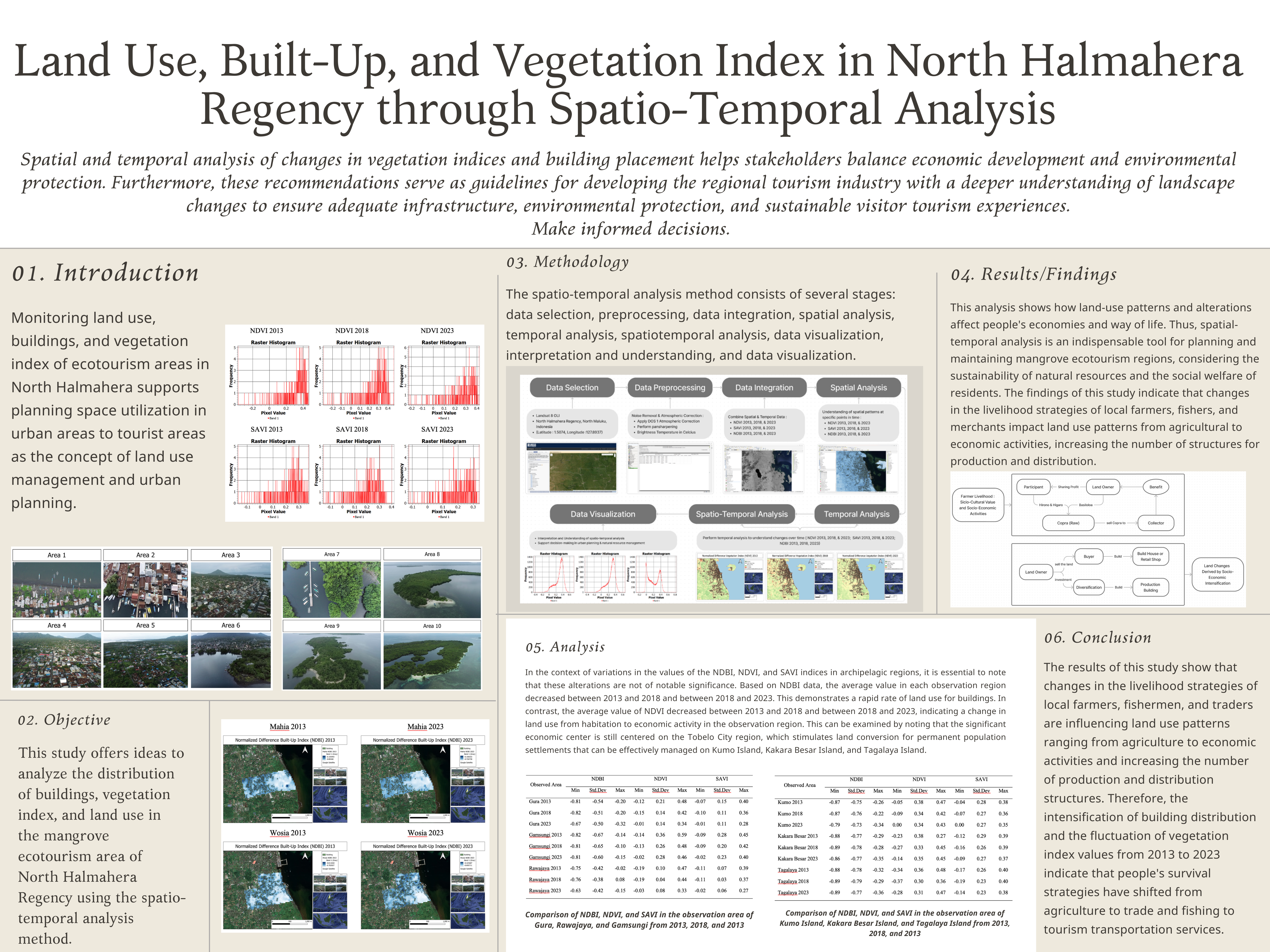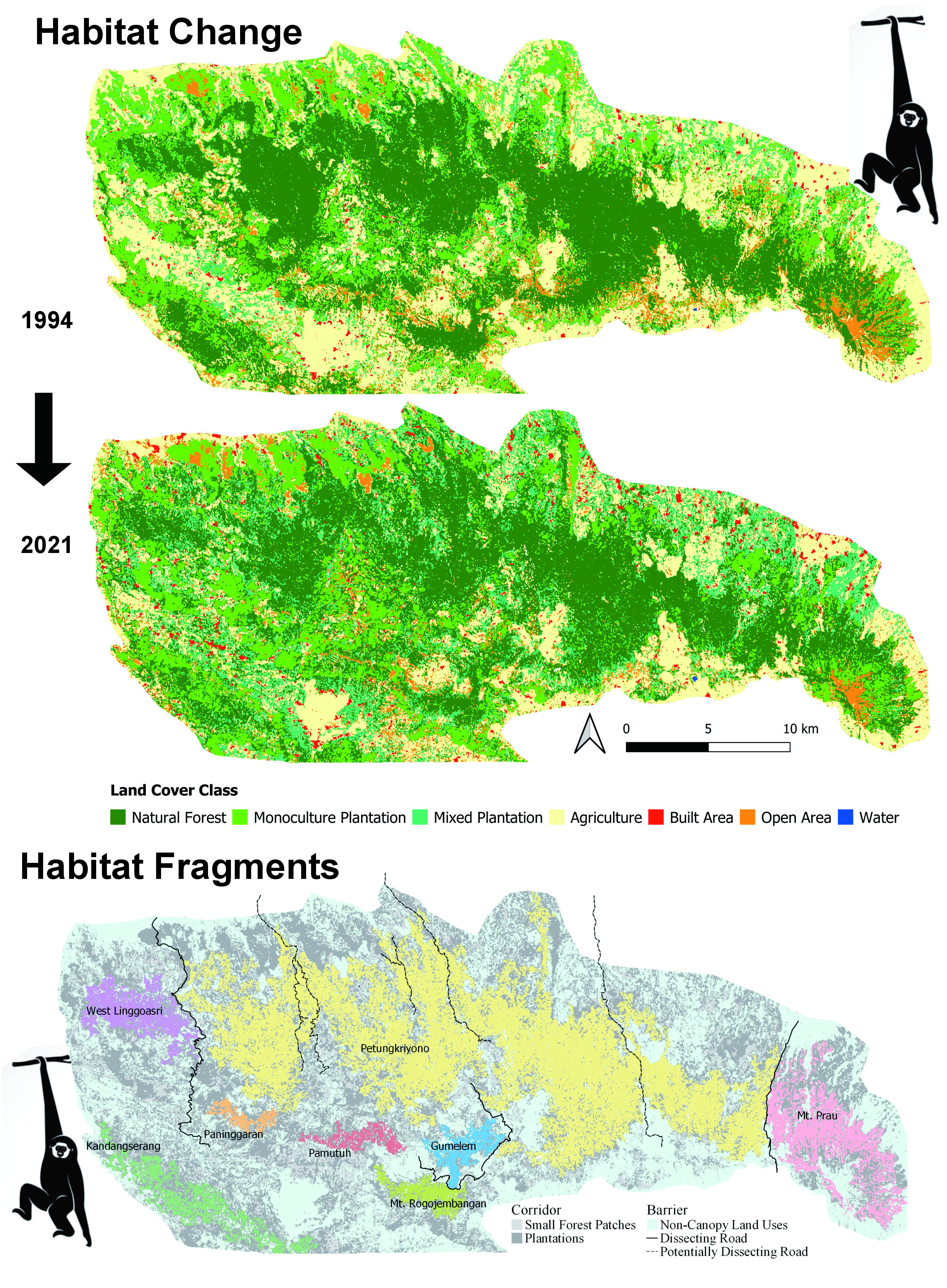Monitoring of Natural Enemies (Hymenoptera) on Different Lands Use: Study from Agroforestry, Community Forest, and Pioneer Land
Abstract
Land use and management must be carried out in a way that ensures the sustainability of land ecological function. The presence of natural enemies that suppress pest populations is an important component of the ecological function. Monitoring the presence of natural enemies and avoiding silvicultural activities that threaten the presence of natural enemies are important aspects of land management. This study investigates the presence of natural enemies on three different lands: agroforestry, community forests, and pioneer lands. Monitoring was carried out during three months at three types of land use by using observation plot in the square form of 20 x 20 m2. Insect collection in the field uses pitfalls and sticky traps which are placed using a grid and a diagonal method, respectively. Phytophagous insects, such as leafhopper, flies, thrips, aphids were surveyed. Hymenoptera natural enemies, predators (Formicidae) and parasitic wasps (Trichogrammatidae and Scelionidae) were obtained. The results show that community forests and pioneer lands are support the existence of Formicidae. This study indicates that in the agroforestry there are variations in population of Formicidae based on the period of on-going land management. Agroforestry provides a more suitable place for the existence of Trichogrammatidae and Scelionidae.
References
Allan, E., Weisser, W. W., Fischer, M., Schulze, E. D., Weigelt, A., Roscher, C., ..., & Ebeling, A. (2013). A comparison of the strength of biodiversity effects across multiple functions. Oecologia, 173(1), 223–237. https://doi.org/10.1007/s00442-012-2589-0
Anggara, A. W., Buchori, D., & Pudjianto. (2016). Kemapanan parasitoid Telenomus remus (Hymenoptera: Scelionidae) pada agroekosistem sederhana dan kompleks. Jurnal Hama dan Penyakit Tumbuhan, 3(3), 111–125.
Anjos, D., Campos, R., Campos, R., & Ribeiro, S. (2017). Monitoring effect of fire on ant assemblages in Brazilian rupestrian grasslands: Contrasting effects on ground and arboreal fauna. Insects, 8(3), 64. https://doi.org/10.3390/insects8030064
Aristizábal, N. & Metzger, J. P. (2018). Landscape structure regulates pest control provided by ants in sun coffee farms. Journal of Applied Ecology, 56(1), 21–30. https://doi.org/10.1111/1365-2664.13283
Bianchi, F. J., Booij, C. J. H., & Tscharntke, T. (2006). Sustainable pest regulation in agricultural landscapes: A review on landscape composition, biodiversity and natural pest control. Proceedings of the Royal Society B: Biological Sciences, 273, 1715–1727. https://doi.org/10.1098/rspb.2006.3530
Boa, E. R., & Lenne, J. M. (1996). Diseases and insect pests. In J. L. Stewart, G. E. Allison, & A. J. Simons, Gliricidia sepium. Genetic resources for farmers (pp. 73–76). Oxford: Oxford Forestry Institute.
Bolton, B. (1994). Identification guide to the ant genera of the world. Cambridge: Harvard University Press.
Borror, D. J., Triplehorn, C. A., & Johnson, N. F. (1989). An Introduction to the study of insects (5th ed.). Philadelphia: Sauders College Publishing.
Castagneyrol, B., Bonal, D., Damien, M., Jactel, H., Meredieu, C., Muiruri, E. W., & Barbaro, L. (2017). Bottom‐up and top‐down effects of tree species diversity on leaf insect herbivory. Ecology and Evolution, 7(10), 3520–3531. https://doi.org/10.1002/ece3.2950
Chen, Y. Q., Li, Q., Chen, Y. L., Lu, Z. X., & Zhou, X. Y. (2011). Ant diversity and bio-indicators in land management of lac insect agroecosystem in Southwestern China. Biodiversity and Conservation, 20(13), 3017–3038. https://doi.org/10.1007/s10531-011-0097-x
Clemente-Orta, G., Madeira, F., Batuecas, I., Sossai, S., Juárez-Escario, A., &Albajes, R. (2020). Changes in landscape composition influence the abundance of insects on maize: The role of fruit orchards and alfalfa crops. Agriculture, Ecosystems and Environment, 291, p.106805. https://doi.org/10.1016/j.agee.2019.106805
[COMACO] Community Market for Conservation. (2014). Draft environmental and social management framework (ESMF). The COMACO landscape management project P144254. Retrieved from https://ewsdata.rightsindevelopment.org/files/documents/54/WB-P144254_5Ib8lot.pdf
Connor, E. F., Courtney, A. C., & Yoder, J. M. (2000). Individuals area relationships: The relationship between animal population density and area. Ecology, 81, 734–748. https://doi.org/10.1890/0012-9658(2000)081[0734: IARTRB]2.0.CO;2
Dassou, A. G. & Tixier, P. (2016). Response of pest control by generalist predators to local‐scale plant diversity: A meta‐analysis. Ecology and Evolution, 6(4), 1143–1153. https://doi.org/10.1002/ece3.1917
Davidson, D. W., Cook, S. C., Snelling, R. R. & Chua, T. H. (2003). Explaining the abundance of ants in lowland tropical rainforest canopies. Science, 300, 969–972. https://doi.org/10.1126/science.1082074
Dominguez, E., Murillo, V., & Orwat, J. (2021). Leafhopper food plants in a Neotropical forest in Panama (Hemiptera: Cicadellidae). Anais da Academia Brasileira de Ciências, 93. https://doi.org/10.1590/0001-3765202120190171
El-Wakeil, N. & Volkmar, C. (2013). Monitoring of wheat insects and their natural enemies using sticky traps in wheat. Archives of Phytopathology and Plant Protection, 46(13), 1523–1532. https://doi.org/10.5772/54199
Ebeling, A., Hines, J., Hertzog, L. R., Lange, M., Meyer, S. T., Simons, N. K., & Weisser, W. W. (2018). Plant diversity effects on arthropods and arthropod-dependent ecosystem functions in a biodiversity experiment. Basic and Applied Ecology, 26, 50–63. https://doi.org/10.1016/j.baae.2017.09.014
Forister, M. L., Pelton, E. M., & Black, S. H. (2019). Declines in insect abundance and diversity: We know enough to act now. Conservation Science and Practice, 1(8), p.e80. https://doi.org/10.1111/csp2.80
Fornoff, F., Staab, M., Zhu, C. D., & Klein, A. M. (2021). Multi-trophic communities re-establish with canopy cover and microclimate in a subtropical forest biodiversity experiment. Oecologia, 196, 289–301. https://doi.org/10.1007/s00442-021-04921-y
Freytag, P. H. & Sharkey, M. J. (2002). A preliminary list of the leafhoppers (Homoptera: Cicadellidae) of Colombia. Biota Colombiana, 3(2), 235–283.
Goulet, H, & Huber, J. T. (1993). Hymenoptera of the world: An identification guide to families. Ottawa: Canada Communication Group Publishing.
Grubisic, M., van Grunsven, R. H., Kyba, C. C., Manfrin, A., & Hölker, F. (2018). Insect declines and agroecosystems: Does light pollution matter? Annals of Applied Biology, 173(2), 180–189. https://doi.org/10.1111/aab.12440
Halim, M., Aman-Zuki, A., Ahmad, S. Z. S., Din, A. M. M., Rahim, A. A., Masri, M. M. M., ..., & Yaakop, S. (2018). Exploring the abundance and DNA barcode information of eight parasitoid wasps species (Hymenoptera), the natural enemies of the important pest of oil palm, bagworm, Metisa plana (Lepidoptera: Psychidae) toward the biocontrol approach and it's application in Malaysia. Journal of Asia-Pacific Entomology, 21(4), 1359–1365. https://doi.org/10.1016/j.aspen.2018.10.012
Hamblin, A. L., Youngsteadt, E., & Frank, S. D. (2018). Wild bee abundance declines with urban warming, regardless of floral density. Urban Ecosystems, 21(3), 419–428. https://doi.org/10.1007/s11252-018-0731-4
Hernández‐Flores, J., Flores‐Palacios, A., Vásquez‐Bolaños, M., Toledo‐Hernández, V.H., Sotelo‐Caro, O., & Ramos‐Robles, M. (2021). Effect of forest disturbance on ant (Hymenoptera: Formicidae) diversity in a Mexican tropical dry forest canopy. Insect Conservation and Diversity, 14(3), 393–402. https://doi.org/10.1111/icad.12466
Heterick, B. E. (2009). A guide to the ants of south-western Australia. Perth: Western Australian Museum.
Honek, A., Martinkova, Z., Saska, P., & Dixon, A. F. G. (2018). Aphids (Homoptera: Aphididae) on winter wheat: Predicting maximum abundance of Metopolophium dirhodum. Journal of Economic Entomology, 111(4), 1751–1759. https://doi.org/10.1093/jee/toy157
Huang, A., Xu, Y., Sun, P., Zhou, G., Liu, C., Lu, L., ..., & Wang, H. (2019). Land use/land cover changes and its impact on ecosystem services in ecologically fragile zone: A case study of Zhangjiakou City, Hebei Province, China. Ecological Indicators, 104, 604–614. https://doi.org/10.1016/j.ecolind.2019.05.027
Jactel, H., Bauhus, J., Boberg, J., Bonal, D., Castagneyrol, B., Gardiner, B., ..., & Brockerhoff, E. G. (2017). Tree diversity drives forest stand resistance to natural disturbances. Current Forestry Reports, 3(3), 223–243. https://doi.org/10.1007/s40725-017-0064-1
Karuppaiah, V., & Sujayanad, G. K. (2012). Impact of climate change on population dynamics of insect pests. World Journal of Agricultural Sciences, 8(3), 240–246.
Kazemi, H., Klug, H., & Kamkar, B. (2018). New services and roles of biodiversity in modern agroecosystems: A review. Ecological Indicators, 93, 1126–1135. https://doi.org/10.1016/j.ecolind.2018.06.018
Kishimoto-Yamada, K., Ishikawa, T., Saito, M. U., Meleng, P., Tanaka, H. O., & Itioka, T. (2015). Canopy crane survey of the hemipteran assemblage structure in a Bornean forest. Raffles Bulletin of Zoology, 63, 471–483. http://doi.org/10.5281/zenodo.5385839
Kos, M., Broekgaarden, C., Kabouw, P., Oude Lenferink, K., Poelman, E. H., Vet, L. E., ..., & van Loon, J. J. (2011). Relative importance of plant‐mediated bottom‐up and top‐down forces on herbivore abundance on Brassica oleracea. Functional Ecology, 25(5), 1113–1124. https://doi.org/10.1111/j.1365-2435.2011.01871.x
Koul, O., & Dhaliwal, G. S. (2003). Predators and parasitoids Vol. 3. New York: Taylor Francis.
Krebs, C. J. (1989). Ecological methodology. New York: Harper Collins Publisher.
Krebs, C. J. (2009). Ecology: The experimental analysis of distribution and abundance (6th ed.). San Francisco: Benjamin Cummings.
Latifian, M., Habibpour, B., & Kard, B. (2018). Predator ants of the date palm termite Microcerotermes diversus Silvestri and effects of ant morphometric characteristics on ant functional response. American Journal of Entomology, 2(2), 16–22.
Leather, S. R. & Pope, T. W. (2019). Botanical biopesticides–where to now?. Outlooks on Pest Management, 30(2), 75–77. https://doi.org/10.1564/v30-apr-07
Leidinger, J., Seibold, S., Weisser, W. W., Lange, M., Schall, P., Türke, M., & Gossner, M. M. (2019). Effects of forest management on herbivorous insects in temperate Europe. Forest ecology and Management, 437, 232–245. https://doi.org/10.1016/j.foreco.2019.01.013
Mahesh, P., Srikanth, J., Salin, K. P., Singaravelu, B., Chandran, K. & Mahendran, B. (2019). Phenology of sugarcane leaf hopper Pyrilla perpusilla (Walker) (Homoptera: Lophopidae) and its natural enemies in a crop island scenario. Crop Protection, 120, 151–162. https://doi.org/10.1016/j.cropro.2019.02.020
Martin, N. A. & Mound, L. A. (2004). Host plants for some New Zealand thrips (Thysanoptera: Terebrantia). New Zealand Entomologist, 27(1), 119–123. https://doi.org/10.1080/00779962.2004.9722133
Masfiyah, E., Karindah, S., & Puspitarini, R. D. (2014). Asosiasi serangga predator dan parasitoid dengan beberapa jenis tumbuhan liar di ekosistem sawah. Jurnal Hama dan Penyakit Tumbuhan, 2(2), 9–14.
McCravy, K. W. (2018). A review of sampling and monitoring methods for beneficial arthropods in agroecosystems. Insects, 9(4), 170. https://doi.org/10.3390/insects9040170
Mia, M. R., Amin, M. R., Rahman, H., & Miah, M. G. (2019). Scenario of insect pests, predators and pollinators associated with crop plants in an agroforestry in Bangladesh. SAARC Journal of Agriculture, 17(1), 13–22. https://doi.org/10.3329/sja.v17i1.42758
Offenberg, J. (2015). Ants as tools in sustainable agriculture. Journal of Applied Ecology, 52(5), 1197–1205. https://doi.org/10.1111/1365-2664.12496
Parsons, S. E., & Frank, S. D. (2019). Urban tree pests and natural enemies respond to habitat at different spatial scales. Journal of Urban Ecology, 5(1), juz010. https://doi.org/10.1093/jue/juz010
Quacchia, A., Ferracini, C., Nicholls, J. A., Piazza, E., Saladini, M. A., Tota, F., Melika, G. & Alma, A., (2013). Chalcid parasitoid community associated with the invading pest Dryocosmus kuriphilus in north‐western Italy. Insect Conservation and Diversity, 6(2), 114–123. https://doi.org/10.1111/j.1752-4598.2012.00192.x
Rehman, A., & Powell, W. (2010). Host selection behaviour of aphid parasitoids (Aphidiidae: Hymenoptera). Journal of Plant Breeding and Crop Science, 2(10), 299–311. https://doi.org/10.5897/JPBCS.9000077
Rosa-Schleich, J., Loos, J., Mußhoff, O., & Tscharntke, T. (2019). Ecological-economic trade-offs of diversified farming systems–A review. Ecological Economics, 160, 251–263. https://doi.org/10.1016/j.ecolecon.2019.03.002
Schuh, R. T., & Slater, J. A. (1995). True bugs of the world (Hemiptera: Heteroptera). Classification and natural history. New York: Cornell University Press.
Setyadin, Y., Abida, S. H., Azzamuddin, H., Rahmah, S. F., & Leksono, A. S. (2017). Efek refugia tanaman jagung (Zea mays) dan tanaman kacang panjang (Vigna cylindrica) pada pola kunjungan serangga di sawah padi (Oryza sativa) Dusun Balong, Karanglo, Malang. Biotropika: Journal of Tropical Biology, 5(2), 54–58. https://doi.org/10.21776/ub.biotropika.2017.005.02.3
Shin, B., Lee, J. Y., Kim, N. H., & Choi, S. W. (2021). The relationship between resource abundance and insect herbivory on islands. Plos One, 16(8), p.e0256183. https://doi.org/10.1371/journal.pone.0256183
Staab, M. & Schuldt, A. (2020). The influence of tree diversity on natural enemies–A review of the “Enemies” hypothesis in forests. Curr Forestry Rep, 6, 243–259. https://doi.org/10.1007/s40725-020-00123-6
Stüber, M., Tack, A. J., Zewdie, B., Mendesil, E., Shimales, T., Ayalew, B., ..., & Hylander, K. (2021). Multi‐scale mosaics in top‐down pest control by ants from natural coffee forests to plantations. Ecology, 102(7), e03376. https://doi.org/10.1002/ecy.3376
Suenaga, H., (2017). Ants (Hymenoptera: Formicidae) as potential egg predators of lepidopteran pests of sweet potato, Ipomoea batatas (Solanales: Convolvulaceae), in Japan. Applied Entomology and Zoology, 52(2), 197–207. https://doi.org/10.1007/s13355-016-0468-6
Suryanto, P., Tohari, & Sabarnurdin, M. S. (2005). Dinamika sistem berbagai sumberdaya (resouces sharing) dalam agroforestri: Dasar pertimbangan penyusun strategi silvikultur. Ilmu Pertanian, 12(2), 165–178.
Terayama, M. (2009). A synopsis of the family Formicidae of Taiwan (Insecta, Hymenoptera). Research Bulletin of Kanto Gakuen University. Liberal Arts, 17, 81–266.
Tougeron, K., Damien, M., Le Lann, C., Brodeur, J., & van Baaren, J. (2018). Rapid responses of winter aphid-parasitoid communities to climate warming. Frontiers in Ecology and Evolution, 6, 173. https://doi.org/10.3389/fevo.2018.00173
Triplehorn, C. A., & Johnson, N. F. (2005). Borror and DeLong’s introduction to the study of insects (7th ed.). Belmont, California: Thomson Brooks/Cole.
Triyogo, A., Budiadi, Widyastuti, S. M., Subrata, S. A., & Budi, S. S. (2020). Abundance of ants (Hymenoptera: Formicidae) and the functional groups in two different habitats. Biodiversitas, 21(5), 2079–2087. https://doi.org/10.13057/biodiv/d210535
Thomson, L. J., & Hoffmann, A. A. (2009). Vegetation increases the abundance of natural enemies in vineyards. Biological Control, 49(3), 259–269. https://doi.org/10.1016/j.biocontrol.2009.01.009
Triapitsyn, S. V., Shih, H. T., & Huang S. H. (2018, September 4–6). Identification of the egg parasitoids of Auchenorrhyncha (Hemiptera) of economic importance in Taiwan: Collaborative research between Taiwan Agricultural Research Institute and University of California at Riverside Scientists. In H. T. Shih, & C. J. Chang (Eds.), Proceedings of the 2018 international symposium on proactive technologies for enhancement of integrated pest management of key crops (pp. 4–16). Taiwan Agricultural Research Institute, Council of Agriculture, Taichung, Taiwan.
Vanwalleghem, T., Gómez, J. A., Amate, J. I., de Molina, M. G., Vanderlinden, K., Guzmán, G., ..., & Giráldez, J. V. (2017). Impact of historical land use and soil management change on soil erosion and agricultural sustainability during the Anthropocene. Anthropocene, 17, 13–29. https://doi.org/10.1016/j.ancene.2017.01.002
Vargas, G., Gómez, L. A., & Michaud, J. P. (2015). Sugarcane stem borers of the Colombian Cauca River Valley: Current pest status, biology, and control. Florida entomologist, 98(2), 728–735. https://doi.org/10.1653/024.098.0249
Wang, E., Martre, P., Zhao, Z., Ewert, F., Maiorano, A., Rötter, R. P., ..., & Reynolds, M. P. (2017). The uncertainty of crop yield projections is reduced by improved temperature response functions. Nature Plants, 3(8), 1–13. https://doi.org/10.1038/nplants.2017.102
Wang, Y., Lehnert, L.W., Holzapfel, M., Schultz, R., Heberling, G., Görzen, E., ..., & Fu, Y. (2018). Multiple indicators yield diverging results on grazing degradation and climate controls across Tibetan pastures. Ecological Indicators, 93, 1199–1208. https://doi.org/10.1016/j.ecolind.2018.06.021
Widihastuty, Tobing, M. C., Marheni, & Kuswardani, R. A. (2018). The potential of Myopopone castanea (Hymenoptera: Formicidae) as a predator for Oryctes rhinoceros Linn. larvae (Coleoptera: Scarabaeidae). Journal of Physics: Conference Series, 1116, 052074. https://doi.org/10.1088/1742-6596/1116/5/052074
Wielgoss, A., Tscharntke, T., Rumede, A., Fiala, B., Seidel, H., Shahabuddin, S., & Clough, Y. (2014). Interaction complexity matters: Disentangling services and disservices of ant communities driving yield in tropical agroecosystems. Proceedings of the Royal Society B. Biological Sciences, 281, 20132144. https://doi.org/10.1098/rspb.2013.2144
Yanoviak, S. P., & Kaspari, M. (2000) Community structure and the habitat templet: ants in the tropical forest canopy and litter. Oikos, 89, 259–266. https://doi.org/10.1034/j.1600-0706.2000.890206.x
Zettler, J. A., Taylor, M. D., Allen, C. R., & Spira, T. P. (2004). Consequences of forest clear-cuts for native and nonindigenous ants (Hymenoptera: Formicidae). Annals of the Entomological Society of America, 97, 513–518. https://doi.org/10.1603/0013-8746(2004)097[0513:COFCFN]2.0.CO;2
Authors

This work is licensed under a Creative Commons Attribution 4.0 International License.
Jurnal Manajemen Hutan Tropika is an open access journal which means that all contents is freely available without charge to the user or his/her institution. Users are allowed to read, download, copy, distribute, print, search, or link to the full texts of the articles in this journal without asking prior permission from the publisher or the author. This is in accordance with the Budapest Open Access Initiative (BOAI) definition of open access.






